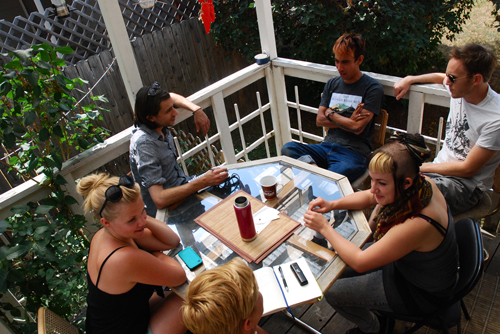eX(change)Ways | a kinda+wild collaboration
This summer EAS turned its focus to collaboration. We asked how collaboration affects the way we view and understand art, how it challenges the role of the artist, how it expands our concept of process, and how it nurtures broader relationships of social, political and personal issues. Last month, we explored these questions through a collaborative project with two American collectives, The Wildfire in Bozeman, Montana and Kinda in Denver, Colorado.
 The project, Exchange Ways, was an experiment with art and social engagement. First, the two groups met in Denver, Colorado to work with teenagers at Synergy, an adolescent treatment center. Synergy provides highly specialized treatments for three interrelated disorders: substance use, conduct disorder, and other co-occurring mental health disorders. Wildfire and Kinda Collectives conducted a multi-day workshop on the concept of ‘legacy,’ producing visual lifelines and video memorials. Through creating these artifacts, the project cultivated a unique perspective of life’s scale and the short span of a teenage life. While the project’s primary aim was to engage the residents of the treatment center, it also deeply impacted the facilitators. The conscious act of stepping out of one’s own space to engage with a particular community on an intimate level fuels critical individual reflection. This reflection allows space for an expanding lens on the diversity of personal and social experience. Through the collaborative process the two collectives built new networks, strengthening the connections between each other and the participants.
The project, Exchange Ways, was an experiment with art and social engagement. First, the two groups met in Denver, Colorado to work with teenagers at Synergy, an adolescent treatment center. Synergy provides highly specialized treatments for three interrelated disorders: substance use, conduct disorder, and other co-occurring mental health disorders. Wildfire and Kinda Collectives conducted a multi-day workshop on the concept of ‘legacy,’ producing visual lifelines and video memorials. Through creating these artifacts, the project cultivated a unique perspective of life’s scale and the short span of a teenage life. While the project’s primary aim was to engage the residents of the treatment center, it also deeply impacted the facilitators. The conscious act of stepping out of one’s own space to engage with a particular community on an intimate level fuels critical individual reflection. This reflection allows space for an expanding lens on the diversity of personal and social experience. Through the collaborative process the two collectives built new networks, strengthening the connections between each other and the participants.
The following week the two collectives collaborated on conceiving and constructing a participatory installation in a community space along the main street of Bozeman, a college town in Southern Montana. The space, run by the Wildfire Collective, serves as a library, resource center, workshop, and meeting room. The installation generated an ideals map that spanned half the room; participants were invited to select string attached to an ideal they prioritize and attach it to a central point, creating a visual diagram of values. The most obvious aim of the piece was to engage community members through a symbolic physical act of community participation. The underlying intent of the project was to encourage people to come into the space to cultivate connection through involvement in the process.
 Newly established, the space shows great potential for public utilization. This project attracted attention to the space and its purpose. The two collectives spent several days in the space installing the piece and inviting visitors to join in the process. Public curiosity through the spectacle of art process cultivated valuable attention to the space; with the hope that this attention translates into increasing its use as a public resource.
Newly established, the space shows great potential for public utilization. This project attracted attention to the space and its purpose. The two collectives spent several days in the space installing the piece and inviting visitors to join in the process. Public curiosity through the spectacle of art process cultivated valuable attention to the space; with the hope that this attention translates into increasing its use as a public resource.
These projects were embarked upon with open aims and broad intentions and challenged both the concept of authorship and the artist's role in a social context. They create a strong sense of ownership through all levels of participation, and the impact is largely embodied in the process itself. The definition of social practice in the context of art is often ambiguous, but when the work is collaborative, context becomes the main medium. What forms the art piece is not the physical material but rather the social conditions through which we are working, as a result the outcome often moves beyond our expectations.
More info : Wildfire Collective | Kinda Collective

